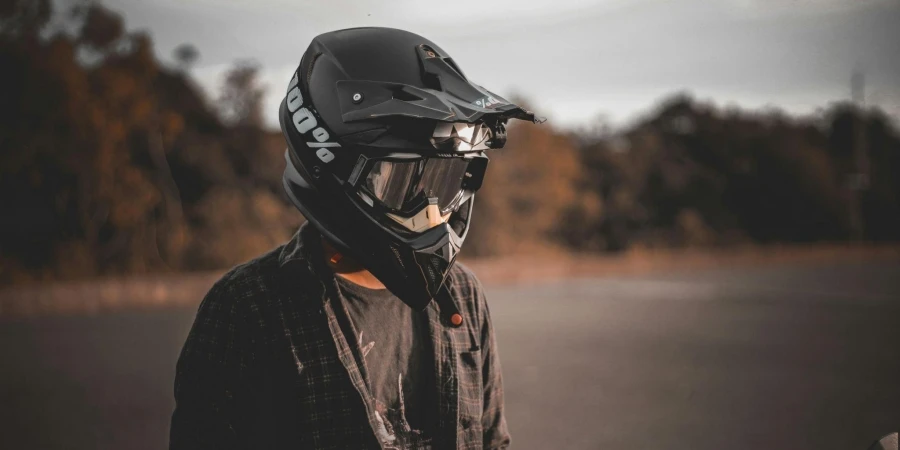Table of Contents
● Introduction
● Understanding the main types of motorcycle helmets
● 2025 market trends in motorcycle helmets
● Key factors to consider when choosing helmets
● Leading models for 2025: Best options for every need
● Conclusion
Introduction
Choosing the appropriate motorcycle helmet is crucial for guaranteeing safety and comfort and optimizing performance in 2025. With technological progressions in mind, helmets serve a purpose beyond mere protection gear by incorporating advanced design elements such as lightweight materials for reduced strain during extended wear periods and improved airflow to keep riders cool during hot rides. They also integrate cutting-edge communication capabilities, all while conforming to stringent safety guidelines like ECE 22.06. Riders stand to gain significantly from helmets that are customized to their riding preferences. Whether cruising through city streets, embarking upon off-road expeditions, or tackling high-speed circuits, selecting a quality helmet can significantly enhance the ride by reducing fatigue and increasing focus while providing protection and efficiency.
Understanding the main types of motorcycle helmets

Full-face Helmets: Maximum Protection for All Riders
Full-face helmets protect riders by encompassing the whole head and face area. These helmets are popular for their safety features in fast-paced settings. They are especially renowned for minimizing wind resistance and noise while offering aerodynamics that appeal to commuters in urban areas and those who ride long distances. Contemporary styles incorporate ventilation systems that maintain airflow without sacrificing safety measures to guarantee comfort during prolonged journeys.
Full-face helmets do not offer just protection, they also feature anti-fog visors for clear vision in varying conditions, UV protection to shield against harmful sun rays, and multi-layered EPS liners that enhance shock absorption effectiveness. Furthermore, these helmets are advancing using materials such as carbon fiber to reduce weight without compromising durability. For individuals who value both safety and comfort while riding, full-face helmets are a top choice that will continue to be relevant in 2025.
Modular Helmets: Flexibility with Safety
Modular helmets provide the safety features of full-face helmets while offering the practicality of open-face designs by incorporating a front mechanism that enables riders to raise the chin bar and switch between full-face and open-face modes easily. These versatile helmets are well suited for navigating city streets or embarking on long-distance journeys as they allow riders to adjust for airflow or communicate effortlessly when needed.
Modular helmets may be a bit weightier because of their hinge mechanism; however, they offer top-notch protection when the chin bar is secured. With added perks, like built-in sun visors, advanced ventilation systems, and noise-free performance, modular helmets are favored by riders looking for comfort and versatility. In 2025, their functionality will keep them in demand among various groups of riders.
ADV and Off-road Helmets: Performance in Extreme Conditions
Riders who explore rough terrains and embark upon long-distance adventures often opt for adventure helmets designed to meet their needs. The built-in peak visors effortlessly shield against the sun’s glare and flying debris; the wider visor openings also accommodate goggles for off-road rides. These helmets cater to riders traversing rugged roads and rough landscapes by providing safety and adaptability.
Ventilation systems in these helmets guarantee air circulation for riders during challenging off-road journeys to maintain a cool feel in hot weather conditions. They incorporate materials like carbon composites to decrease tiredness and feature moisture-wicking liners for comfort. In the year 2025, you can expect ADV helmets to continue being the preferred option for adventure lovers looking for top performance in extreme environments.
2025 Market Trends in Motorcycle Helmets

In 2023, the worldwide motorcycle helmet market was estimated to be worth $10 billion. It is predicted to grow to $34 billion by 2032, with an expected growth rate of 13%.
Safety Regulations: The Rise of ECE 22.06 Certification
In 2025, a notable change in motorcycle helmet standards is the growing acceptance of ECE 22.06 certification, which supersedes ECE 22.05 regulation. The new European guidelines bring new testing procedures to guarantee better protection for bikers. These updated criteria require helmets to undergo low-speed impact tests, chin bar evaluations, and rotational forces assessments to ensure improved safety in various crash situations. The thorough examinations established a standard for ensuring helmet safety and prompted manufacturers to revamp their products to align with these stringent rules.
The increasing concern for the safety of riders has sparked a growing interest in ECE 22.06-certified helmets not only in Europe but in many other markets around the globe. Riders and businesses are anticipated to show a preference for helmets that meet these elevated safety criteria more. This change will likely result in a rise in the need for helmets crafted with state-of-the-art materials and liners that resist impacts and advanced safety attributes. With the increasing number of countries adopting safety standards in line with ECE 22.06 specifications for helmets, these compliant helmets are expected to be the leading choice in the market by 2025, spurring advancements in design and materials used in helmet technology.
Increased Demand for Lightweight and Comfortable Designs
By 2025, there is a growing interest in lightweight helmets that provide comfort among consumers who prioritize safety and comfort. Riders are now looking for helmets crafted from carbon fiber and composites that balance ride durability and comfort. This shift has also been influenced by improvements in ventilation technology, with helmets now featuring airflow systems to increase rider comfort across different weather conditions. Wearing helmets with ventilation systems and moisture-wicking inner linings is becoming increasingly crucial for those engaging in long-distance touring and adventurous motorbike rides.
Moreover, as helmets develop to adhere to safety regulations, companies are giving importance to creating designs that enhance comfort and ergonomics. Variations in sizes and the option for personalized padding are increasingly prevalent, enabling a customized fit that minimizes discomfort and boosts the rider’s concentration. This increased focus on comfort aligns with the prevailing market trends projected for 2025, where the combination of construction and advanced ventilation systems is expected to characterize the helmet models in the field.
Key Factors to Consider When Choosing Helmets

Safety Certifications and Standards
When selecting a motorcycle helmet, safety certification is a consideration that shouldn’t be overlooked at all costs. Helmets need to comply with defined safety standards to guarantee protection in the event of a mishap. The DOT (Department of Transportation) and ECE (Economic Commission for Europe) certifications are the ones to look out for. While the U.S. mandates DOT certification for helmets sold there, it is often perceived as having rigorous testing procedures compared to ECE. The latest European standard for helmets, known as ECE 22.06, is well regarded worldwide for its evaluation that covers impact resistance tests and checks on forces and shell durability. Riders commonly seek out helmets that meet these criteria as they offer reliable safety assurance.
Besides DOT and ECE certifications found in helmets, there are also certifications from organizations like Snell or FIM. Snell certification undergoes testing procedures and is commonly preferred for high-performance helmets in racing settings. The FIM standards mainly cater to motorsports and are gradually impacting the design of consumer-grade helmets. Looking ahead to 2025, it is anticipated that ECE 22.06-certified helmets will dominate the market as this standard gains recognition globally, prompting manufacturers to implement stricter safety protocols.
Ventilation and Noise Control
Helmet ventilation systems ensure comfort while riding in various weather conditions by facilitating proper airflow to prevent heat and moisture buildup inside the helmet. The strategic placement of intake and exhaust vents in helmets promotes air circulation to keep riders cool in warm weather conditions. Adventure helmets typically incorporate vent systems to cater to off-road or leisurely riding scenarios where effective heat regulation is vital.
Keeping noise in check is crucial because much wind noise can cause discomfort and tiredness over extended periods. Using helmets with improved insulation, chin spoilers, and sealed visors can lower wind noise levels, resulting in a quieter experience. Riders who embark on tours or high-speed rides tend to favor helmets with noise control attributes. As helmet technology evolves, the industry is emphasizing developing products that balance airflow and noise reduction to keep riders comfortable and attentive throughout their travels.
Communication and Technology Features
Adding communication technology to helmets is an important trend these days. Helmets equipped with Bluetooth technology and those that can work with other communication gadgets after purchase are very popular among riders who tour in groups. Bluetooth connection lets riders communicate hands-free, use GPS navigation, and listen to music while riding safely. Helmets that have built-in communication systems or offer ways to add them are gaining popularity.
Furthermore, helmets nowadays come with speaker compartments and built-in microphones, simplifying the process of adding communication systems without modifying the helmet design. This feature is especially valued by riders covering long distances and daily commuters who need communication while traveling. Technology-enhanced helmets expected to be popular by 2025 will facilitate compatibility with devices meeting the needs of tech-savvy riders seeking safety and convenience in a single product.
Leading Models for 2025: Best Options for Every Need

Best Full-face Helmets for Performance and Safety
Full-face helmets are widely recognized for their protection as they shield both the head and face to guarantee safety during fast rides. In 2025, helmets under this classification still stand out for their improved aerodynamics and state-of-the-art safety functionalities. Some leading models feature impact liners meant to manage crash situations, thus minimizing the chance of harm in vital areas. Moreover, current full-face helmets come with cutting-edge ventilation systems to maintain airflow and ensure rider comfort throughout extended journeys. The helmets come with visors that offer a vision field and are equipped with anti-fog technology to ensure clear visibility in any weather situation.
Performance-oriented riders frequently utilize materials, like carbon composites, to fabricate helmets that decrease wind resistance and lessen exhaustion levels. This type of material bolsters the helmet’s durability and plays a key role in enhancing its aerodynamic performance. Full-face helmets available in 2025 strongly emphasize comfort by providing padding and various shell sizes to accommodate diverse head shapes. These advanced features are tailored to deliver safety and comfort for riders prioritizing top-tier protection and performance. Full-face helmets continue to be the best choice for riders due to their design elements.
Top Modular Helmets for Versatility
In 2025, modular helmets are becoming more popular as they balance the safety of full-face helmets and the convenience of open-face designs by allowing riders to lift the chin bar with their front mechanism, making them suitable for city commutes and long-distance trips. They are designed to offer flexibility so riders can easily switch between full coverage and open-face comfort based on their riding needs. Nowadays, several models come with sun visors that can be easily adjusted while wearing the helmet, offering convenience for individuals in varying situations.
These helmets nowadays come with high-tech features, like noise reduction and sleek designs to reduce wind disturbance while riding motorcycles or bikes. They also offer efficient Bluetooth communication for those who need it during their journey. Modular helmets in 2025 prioritize adaptability, comfort, and safety and provide riders with a better option for their protective gear needs.
Best ADV and Off-road Helmets for Adventure
Helmets for adventures and off-road journeys are made for riders who like to explore terrains on and off the roadways, with features that help improve performance in challenging environments. These helmets are known for their toughness and versatility. They often come with visors to protect riders from sunlight and flying debris while enabling goggles to improve visibility when riding off-road trails. These helmets are crafted using lightweight materials to prevent exhaustion during journeys and offer top-notch safety against impacts in challenging terrains.
Ventilation is essential in ADV and off-road helmets as they feature intake and exhaust openings to maintain airflow during leisurely or intense rides. They now come with customizable peak visors and mounts for action cameras for versatility. These helmets are built to endure tough conditions while ensuring the rider’s comfort, making them a popular option for individuals setting out on long-distance journeys or exploring harsh terrains. Their adaptability across landscapes makes them greatly sought after in the 2025 market.
Conclusion

Choosing the ideal motorcycle helmet for 2025 is crucial to ensure the safety and comfort of riders while enhancing performance levels. With the development of safety standards, like ECE 22.06, and the increasing preference for helmets with improved ventilation systems, helmet designs have reached new heights of sophistication. Full-face, modular, and ADV helmets have unique benefits catering to varying riding preferences and environments. As advancements like built-in communication features become more prevalent in helmets, they are no longer just a safety essential but also an integral part of a rider’s journey. Opting for the right model guarantees an enjoyable ride.




